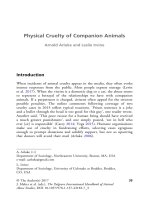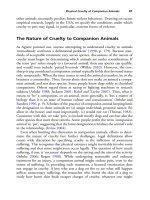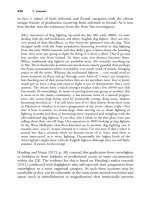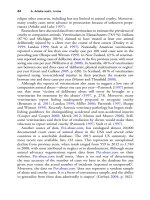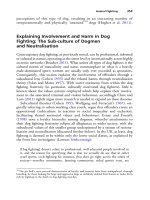The palgrave international handbook of a 352
Bạn đang xem bản rút gọn của tài liệu. Xem và tải ngay bản đầy đủ của tài liệu tại đây (26.56 KB, 1 trang )
350
C. Lawson
in fact, a subset of both informal and formal categories with the almost
unique feature of graduation occurring from informal to formal. As is seen
here further into the testimony from the front line investigator:
[My] experience of dog fighting up until the late 90s, early 2000s, we were
dealing with the old traditional, old white, English dog fighter. They are very,
very proud of their bloodlines, so they breed the gameness into the dog. That
changed really with the Asian population becoming involved in dog fighting
from the early 2000s onwards and they didn’t give a damn about the breeding
lines, they were just going to fight the thing, if it died, it died. They’d go and
buy another one from Ireland. So there were two distinct fractions there.
White, traditional dog fighters are probably more 30s onwards, anything up
to 50s. Their clandestine activities are much more closely guarded than perhaps
the Asian communities where it would be very much word of mouth, bringing
mates in off the street. Whereas the traditional fighters . . . you would need to
know someone in there and go through some form of, I won’t say initiation,
but checking out of their status before they are let anywhere near. You’ve pretty
much got to have a dog and want to fight it too or demonstrate that’s your
interest. The Asians have a much younger bracket with a few 30/40 year olds
but mostly 20-somethings. In terms of moving from one group to another, this
is more so in the Asian community, it has become more of a natural progression—the status dogs being used by potentially young, drug users, dealers,
becoming involved in—I’m still never sure if it’s their history from their roots
in Pakistan or whether it is just a progression of the street culture really—but
that is how it started, it’s status dogs, then moving on to chain fighting or
fighting in parks and then to becoming more organised and mingling with the
old traditional dog fighters, if you like, who I think in the first place were just
selling them their cast off dogs. One operation in 2003 looking at dog fighters
in the West Midlands, that then knocked on to another dog fighting case 6
months later, was 27 Asians arrested at a venue. I’m not sure if that’s when it
started but that’s certainly when we became aware of it. Since then there is
more inter-racial, as it were, fighting. Occasionally the higher levels of the
Asian fighters might meet with the English fighters although they are still fairly
separate. (Lawson forthcoming).
Harding and Nurse (2015, p. 30) contend that graduation from streetfighter
to hobbyist or from hobbyist to professional occurs in some circumstances
within the UK. The evidence for this is based on Harding’s earlier research
(2012) conducted with dogfighters who self-reported their progression from
streetfighter to a more organised category. As such these accounts may be
unreliable as they can be vulnerable to the same issues around machismo and
status (such as embellishment or magnification) that intrinsically interests
